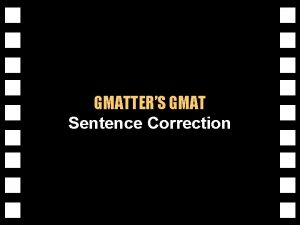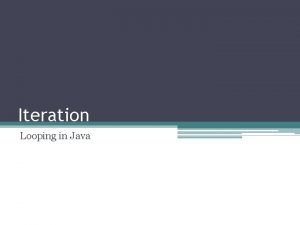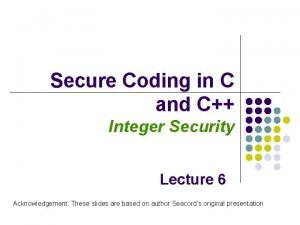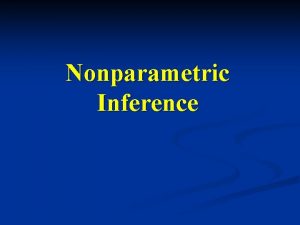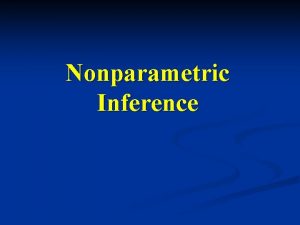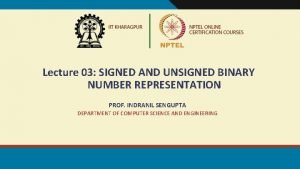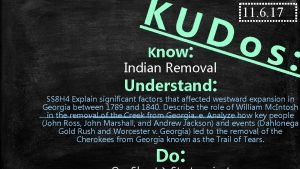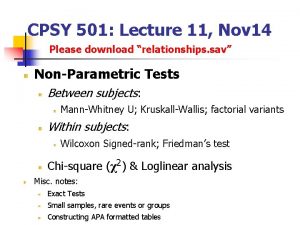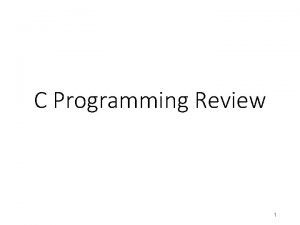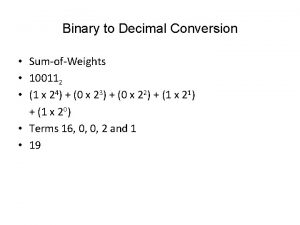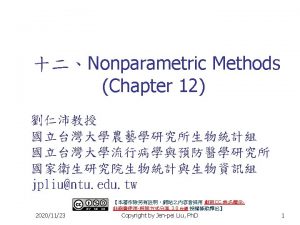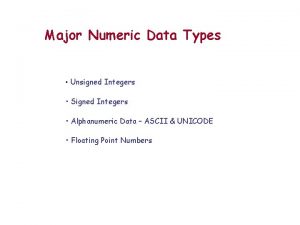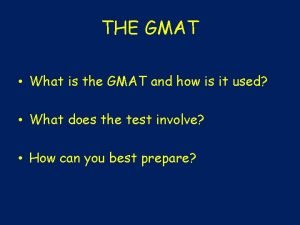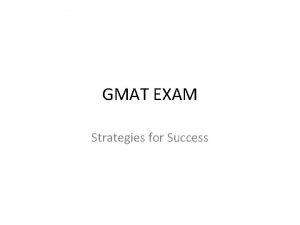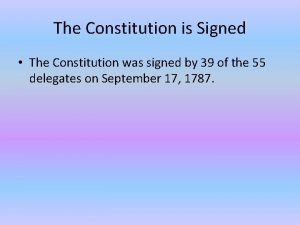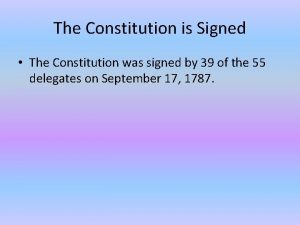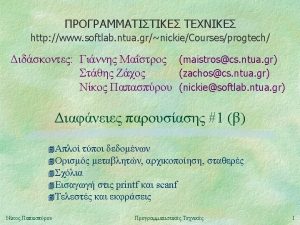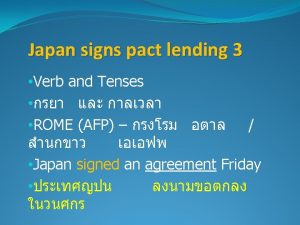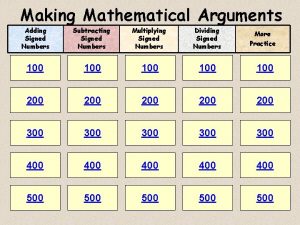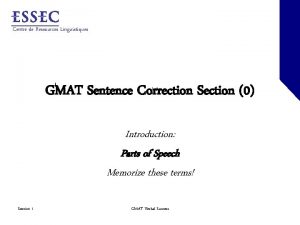GMAT CLASS INTRODUCTION Have you signed up for






































































- Slides: 70

GMAT CLASS INTRODUCTION • Have you signed up for the test? When is your test date? • Who has taken the test before? • Some day-of-the-test advice (video online at www. mba. com) • Some studying advice • You can repeat the class, anytime! Anywhere in California that it’s offered! • How I can help: my professional background

GMAT ESSAY WRITING Successful Strategies For a High Score

GMAT ESSAY WRITING • ESSENTIAL COMPUTER INFORMATION – WHAT THE SCREEN LOOKS LIKE • • • Topic and directions appear on the top of the screen Type the essay in the box below. Delete, Cut, Paste, Undo buttons on right side Vertical Cursor bar Countdown clock

GMAT ESSAY WRITING • ESSENTIAL COMPUTER INFORMATION – WHAT THE SCREEN LOOKS LIKE – WHAT IS AVAILABLE • BASIC WORD PROCESSOR FUNCTIONS • DELETE, CUT, PASTE, UNDO BUTTONS (RIGHT SIDE OF SCREEN) • ENTER KEY (USE FOR PARAGRAPH BREAKS)

• ESSENTIAL COMPUTER INFORMATION – WHAT THE SCREEN LOOKS LIKE – WHAT IS AVAILABLE – WHAT IS NOT AVAILABLE: • • TAB KEY SPELL CHECK DRAG AND DROP TEXT FORMATTING

GMAT ESSAY TOPIC • ANALYSIS OF AN ARGUMENT – Given the “source” and an “argument” – Present an OBJECTIVE CRITIQUE – A hypothetical scenario – “Most” Topics available on MBA website (www. mba. com)

GMAT ESSAY PARAMETERS • TIME: – 30 MINUTES (followed by the 30 minute Integrated Reasoning section) • LENGTH: – 3 PAGES (word count estimates to follow)

GMAT ESSAY SCORING • HOW SCHOOLS MIGHT USE IT • READER INFORMATION • HOLISTIC SCORING – Scale: 1— 6 – Essential rubric points…

GMAT ESSAY SCORING • ESSENTIAL RUBRIC POINTS: – ON TOPIC • Give them what they want for the topic • Stay on topic!

GMAT ESSAY SCORING • ESSENTIAL RUBRIC POINTS: – ON TOPIC – ORGANIZATION • Three-part essay: – Introduction, Body Paragraphs, Conclusion • Logical, unified presentation

GMAT ESSAY SCORING • ESSENTIAL RUBRIC POINTS: – ON TOPIC – ORGANIZATION – DEVELOPMENT • GET AS MANY EXAMPLES AS YOU CAN • THOROUGHLY EXPLAIN YOUR IDEAS

GMAT ESSAY SCORING • ESSENTIAL RUBRIC POINTS: – ON TOPIC – ORGANIZATION – DEVELOPMENT – ADULT, STANDARD WRITTEN ENGLISH • Use correct grammar and usage • Be as sophisticated as you can: – Vary sentence length and patterns – Vary sentence beginnings (check first word in practice) – Don’t begin sentences with the same phrase that the previous sentence ended with

GMAT ESSAY SCORING • ESSENTIAL RUBRIC POINTS: – ON TOPIC – ORGANIZATION – DEVELOPMENT – ADULT, STANDARD WRITTEN ENGLISH • OFFICIAL SCORING GUIDE

GMAT ESSAY SCORING • Simple Transitions: – To introduce and extend examples: • for example, additionally, for instance, a primary consideration, in addition, furthermore, moreover, another reason, equally important, in the same way, equally important, indeed, likewise, similarly – To show contrast: • however, although, another viewpoint, alternately, on the contrary, otherwise, instead, conversely, nevertheless, regardless

GMAT ESSAY SUGGESTIONS • Remember, it’s just a draft! • DOUBLE SPACE between paragraphs! • Use third person pronouns as often as possible; other pronoun advice • Organize before writing • Avoid “wasted words” (list to follow)

Wasted Words and Phrases • • • I think, I feel, I believe, in my opinion, etc. as you can see in conclusion, to conclude, in summarization, to summarize, etc. to begin, to end, etc. quite, very, extremely, basically, essentially, totally, completely there is, there are is why, is because, is that, is what, etc. it can be seen that it has been indicated that it should be remembered that it should be noted that it is imperative that

GMAT ESSAY SUGGESTIONS Score 6 4 2 Word Count Estimate 450+ 250 125

GMAT ESSAY TIMING • 2 -3 minutes: read the topic carefully • 5 minutes: plan the essay 1. Analyze the validity of each sentence, claim, or fact 2. List doubtful assumptions, missing information, and counterexamples or alternative explanations 3. Organize analysis into paragraphs • 20 minutes: write the essay • 2 -3 minutes: proofread

GMAT ESSAY ORGANIZATION • Introduction – One paragraph of about 2 -4 sentences – Address the topic clearly – Include a thesis – See handout for sample thesis

GMAT ESSAY ORGANIZATION • Body Paragraphs – Aim for 2 -3 well-developed paragraphs – Use topic sentences – Use ample, relevant examples – Explain all your logic – Use transitions before examples

GMAT ESSAY ORGANIZATION • Conclusion – One separate paragraph of a few sentences – Refer to thesis, but… – Avoid mere summary; answer “so what? ” – See handout for sample conclusion

GMAT ARGUMENT TOPIC PLANNING • PLANNING ADVICE: – NO complete sentences – NO wasted words – NO worrying about putting examples into the “correct” column

GMAT ARGUMENT DIRECTIONS Discuss how well reasoned you find this argument. In your discussion be sure to analyze the line of reasoning and the use of evidence in the argument. For example, you may need to consider what questionable assumptions underlie thinking and what alternative explanations or counterexamples might weaken the conclusion. You can also discuss what sort of evidence would strengthen or refute the argument, argument what changes in the argument would make it more logically sound, and what, if anything, would help you better evaluate its conclusion.

GMAT ARGUMENT ESSAY TERMS • “what questionable assumptions underlie thinking” = unreasonable or unwarranted assumptions in the logic • “what alternative explanations or counterexamples might weaken the conclusion” = ideas that refute the conclusion; ask “what if…” to help get ideas • “what sort of evidence would strengthen or refute the argument” = questions you want answered, missing information

OTHER POSSIBLE FLAWS Term Description Inherent flaw(s) Extrapolation Taking a specific detail or idea and overgeneralizing from it Missing information Questionable assumptions Apples to Oranges Comparing things that seem to have Questionable assumptions something in common but are quite Missing information distinct Trends Expecting any results to continue without change Ignores counterexamples or alternative explanations Questionable assumptions Sole Factor Thinking a complex end was achieved by one single cause Questionable assumptions Missing information Ignores alternative explanations Weasel words Phrases that create a specific impression are actually vague or ambiguous; the impression can be denied if challenged. Missing information

GMAT ARGUMENT TOPIC PLANNING Given the test directions, try using the following categories to plan your essay: • QUESTIONABLE ASSUMPTIONS • MISSING INFORMAITON • COUNTEREXAMPLES or ALTERNATIVE EXPLANATIONS

GMAT ARGUMENT TOPIC PLANNING The following appeared as part of an annual report sent to stockholders by Olympic Foods, a processor of frozen foods: “Over time, the costs of processing go down because as organizations learn how to do things better, they become more efficient. In color film processing, for example, the cost of a 3 -by-5 -inch print fell from 50 cents for five-day service in 1970 to 20 cents for one-day service in 1984. The same principle applies to the processing of food. And since Olympic Foods will soon celebrate its 25 th birthday, we can expect that our long experience will enable us to minimize costs and thus maximize profits. ”

GMAT ARGUMENT ESSAY PRACTICE The following appeared in a memorandum from the business department of the Apogee Company: “When the Apogee Company had all its operations in one location, it was more profitable than it is today. Therefore, the Apogee Company should close down its field offices and conduct all its operations from a single location. Such centralization would improve profitability by cutting costs and helping the company maintain better supervision of all employees. ”

GMAT ESSAY FINAL ADVICE • • Alternative organizational plan Practice planning; it gets easier! Practice 30 minute essays at the computer Evaluate your essay via the scoring guide essential points: – On topic – Organization – Development – Language Usage

GMAT VERBAL REASONING Understand the visual appearance of each Verbal Reasoning multiple-choice question – READING COMPREHENSION – CRITICAL REASONING – SENTENCE CORRECTION

READING COMPREHENSION FORMAT 300+ WORD PASSAGE LOCATED HERE Question located here, followed by five answer choices o o o Choice one Choice two Choice three Choice four Choice five

CRITICAL REASONING FORMAT SHORT PASSAGE LOCATED HERE, USUALLY MORE THAN ONE SENTENCE Question located here, followed by five answer choices o Choice one o Choice two o Choice three o Choice four o Choice five

SENTENCE CORRECTION FORMAT ONE SENTENCE LOCATED HERE; all or part of it will be underlined. Five options for changing the sentence will follow o Choice one (repeats the original verbatim) o Choice two o Choice three o Choice four o Choice five

Sentence Correction Introduction • Expect about 14 - 15 questions • 1. 75 minutes allowed for each Verbal Reasoning question • Looking for grammatical errors, but don't make something wrong

Sentence Correction Strategies • First, look for most common errors

Sentence Correction Strategies • First, look for most common errors • Strive for correctness of written English

Sentence Correction Strategies • • • First, look for most common errors Strive for correctness of written English Make the least number of changes

Sentence Correction Strategies • • First, look for most common errors Strive for correctness of written English Make the least number of changes Don’t force a wrong answer

Sentence Correction Strategies • • • First, look for most common errors Strive for correctness of written English Make the least number of changes Don’t force a wrong answer Never change the meaning

Sentence Correction Strategies • • • First, look for most common errors Strive for correctness of written English Make the least number of changes Don’t force a wrong answer Never change the meaning Reread the sentence after inserting the answer choice

Sentence Correction Strategies First, look for most common errors Strive for correctness of written English Make the least number of changes Don’t force a wrong answer Never change the meaning Reread the sentence after inserting the answer choice • Read each answer choice carefully • • •

Sentence Correction Strategies First, look for most common errors Strive for correctness of written English Make the least number of changes Don’t force a wrong answer Never change the meaning Reread the sentence after inserting the answer choice • Read each answer choice carefully • Know your pace • • •

COMMON GRAMMATICAL ERRORS • UNIDIOMATIC EXPRESSIONS, REDUNDANCY (see handout for samples from GMAT exams and in text, pgs. 128 -130)

UNIDIOMATIC EXPRESSIONS – The angry employee was forced to comply to the supervisor’s wishes. – The angry employee was forced to comply with the supervisor’s wishes.

REDUNDANT, WORDY PHRASING – The autobiographer’s mistake when writing about his own life was the kind of one that showed that he needed more training. – The autobiographer’s mistake showed that he needed more training.

COMMON GRAMMATICAL ERRORS • unidiomatic expressions, redundancy • VERBAL ERRORS – Tense errors (see handout)

COMMON GRAMMATICAL ERRORS • unidiomatic expressions, redundancy • VERBAL ERRORS – Tense errors (see handout) – Subject-verb agreement

SUBJECT-VERB AGREEMENT A basket containing flowers, gourmet food, and picnic supplies were lost at the train station. basket (singular subject)… were left (plural verb) A basket containing flowers, gourmet food and picnic supplies was lost at the train station.

COMMON GRAMMATICAL ERRORS • unidiomatic expressions, redundancy • VERBAL ERRORS – Tense errors (see handout) – Subject-verb agreement – Parallelism errors

PARALLELISM ERRORS I came, I saw, I began conquering. (past tense, progressive tense) I came, I saw, I conquered. (three past tense verbs)

COMMON GRAMMATICAL ERRORS • unidiomatic expressions, redundancy • VERBAL ERRORS – Tense errors (see handout) – Subject-verb agreement – Parallelism errors – Active vs. passive voice (use active!)

ACTIVE vs. PASSIVE VOICE Always use active! Active: He hit the ball. (subject) (present verb) (direct object) Passive: The ball was hit by him. (direct object) (present perfect verb) (no subject)

COMMON GRAMMATICAL ERRORS • • • unidiomatic expressions, redundancy verbal errors PARALLELISM ERRORS

PARALLELISM ERRORS Rachael thought her art would be as understandable to a critic with an art degree as a person on the street. Rachael thought her art would be as understandable to a critic with an art degree as to a person on the street. (two prepositional phrases, each beginning with to)

PARALLELISM ERRORS In her praise of yearbook camp, our advisor mentioned (1) the good food, food (2) that the location was perfect, perfect and (3) that the camaraderie was superb (The mistake = three items: one adjective-noun phrase, and two noun clauses. ) In her praise of yearbook camp, our advisor mentioned the good food, the perfect location, and the superb camaraderie. (Now all three items are adjective-noun phrases. )

COMMON GRAMMATICAL ERRORS • • unidiomatic expressions, redundancy verbal errors parallelism errors DANGLING OR MISPLACED MODIFIERS

MODIFIER ERRORS Modifiers = participial phrases or adjective clauses that describe (modify) nouns. They must be placed before or after the noun they modify. Let’s first define the terms and see correct examples.

MODIFIER ERRORS Participial Phrases: begin with a present participle (an –ing verb) or a past participle (usually an –ed or -en verb) plus a phrase (usually a prepositional phrase). They must be located right before or after the noun they modify. Laughing hysterically at her joke, joke I tripped over a chair. The lettuce, wilted by the sun, sun looked unappetizing.

MODIFIER ERRORS Adjective clauses: begin with that, which, whom, whose, why, when, where, followed by a subject and verb. Diane felt manipulated by her beagle Santana, whose big, brown eyes pleaded for another cookie. Oreo and Skeeter, Madison's two dogs, competed for the hardboiled egg that bounced across the kitchen floor. Laughter erupted from Annamarie, who hiccupped for seven hours afterward.

MODIFIER ERRORS Now we’ll see some mistakes: While reaching for the salt, his water glass got knocked over. (No! The water glass was not “reaching for the salt. ”) While reaching for the salt, he knocked over his water glass. (Now “he” is doing the action. )

MODIFIER ERRORS Here’s a past participial phrase error: The first dishwasher was driven by a steam engine invented by an Indiana housewife in 1889 (This mistakenly says the Indiana housewife invented the steam engine. ) Invented by an Indiana housewife in 1889, the first dishwasher was driven by a steam engine. (Now the modifier is located where it belongs. )

MODIFIER ERRORS Finally, an adjective clause error: The girl from Arkansas was a favorite of the judges who won the contest (This mistakenly says the judges won the contest, not the girl. ) The girl from Arkansas who won the contest was a favorite of the judges. (Now the clause is located where it belongs. )

COMMON GRAMMATICAL ERRORS • • • unidiomatic expressions, redundancy verbal errors parallelism errors dangling or misplaced modifiers PRONOUN ERRORS

PRONOUN ERRORS Pronouns must have a clear antecedent (a noun the pronoun refers to). On payday, I went out and spent all of it. it (The word “it” has no antecedent. ) After receiving my paycheck, I went out and spent all of it. it (Now “it” refers to the paycheck. )

PRONOUN ERRORS Pronouns must have the correct case (subjective or objective). For compound elements, eliminate the compound and trust your ear. The committee recognized Tom and [I? Me? ] for our community service. (Eliminate “Tom and” and trust your ear. ) The committee recognized me … The committee recognized Tom and me… me

COMMON GRAMMATICAL ERRORS • • • unidiomatic expressions, redundancy verbal errors parallelism errors dangling or misplaced modifiers pronoun errors FAULTY COMPARISONS

FAULTY COMPARISONS Faulty comparisons are logical problems; make sure the items CAN be compared. Alaska is bigger than any state in the union. (NO! Alaska is a state in the union; it cannot be compared to itself. ) Alaska is bigger than any other state in the union.

COMMON GRAMMATICAL ERRORS • • unidiomatic expressions, redundancy verbal errors parallelism errors dangling or misplaced modifiers pronoun errors faulty comparisons ADJECTIVE OR ADVERB USAGE

COMMON GRAMMATICAL ERRORS • • unidiomatic expressions, redundancy verbal errors parallelism errors dangling or misplaced modifiers pronoun errors faulty comparisons adjective or adverb usage OTHER TROUBLESOME PAIRS

GMAT FINAL ADVICE GOOD LUCK!
 Gmat definition
Gmat definition Gmatter
Gmatter Gmat
Gmat Gmat
Gmat They did not reject you they rejected me
They did not reject you they rejected me 12 edges 6 vertices
12 edges 6 vertices In greenfoot, you can cast an actor class to a world class?
In greenfoot, you can cast an actor class to a world class? Who signed the treaty of indian springs
Who signed the treaty of indian springs Signed pleading
Signed pleading Signed addition verilog
Signed addition verilog 4 bit two's complement
4 bit two's complement Kruskal wallis test jmp
Kruskal wallis test jmp Wilcoxon signed rank test
Wilcoxon signed rank test Binary
Binary Was andrew jackson a president
Was andrew jackson a president Who signed the treaty of indian springs
Who signed the treaty of indian springs Char
Char I can’t find _____. does _____ steal it?
I can’t find _____. does _____ steal it? Spss wilcoxon signed rank test
Spss wilcoxon signed rank test Signed and unsigned in c
Signed and unsigned in c Signed number range
Signed number range Multiplying and dividing signed numbers
Multiplying and dividing signed numbers Unsigned signed
Unsigned signed 1101/11 binary division
1101/11 binary division Addition and subtraction with signed magnitude data
Addition and subtraction with signed magnitude data Signed statement for head covering
Signed statement for head covering Signed integer representation
Signed integer representation Republic act no. 10912 is also known as
Republic act no. 10912 is also known as Signed numbers examples
Signed numbers examples Mann whitney u test advantages and disadvantages
Mann whitney u test advantages and disadvantages What is multiplicand and multiplier example
What is multiplicand and multiplier example Hannah haag
Hannah haag Multiplying and dividing signed numbers
Multiplying and dividing signed numbers Edge weight prediction in weighted signed networks
Edge weight prediction in weighted signed networks Plutonium
Plutonium What year was the treaty of versailles signed
What year was the treaty of versailles signed Markable graph
Markable graph Is being signed
Is being signed A message signed with blood to the nation of the cross
A message signed with blood to the nation of the cross Where was the sussex pledge signed
Where was the sussex pledge signed Signed vs unsigned int
Signed vs unsigned int Binary additon
Binary additon Fspos vägledning för kontinuitetshantering
Fspos vägledning för kontinuitetshantering Novell typiska drag
Novell typiska drag Tack för att ni lyssnade bild
Tack för att ni lyssnade bild Ekologiskt fotavtryck
Ekologiskt fotavtryck Varför kallas perioden 1918-1939 för mellankrigstiden?
Varför kallas perioden 1918-1939 för mellankrigstiden? En lathund för arbete med kontinuitetshantering
En lathund för arbete med kontinuitetshantering Adressändring ideell förening
Adressändring ideell förening Tidböcker
Tidböcker A gastrica
A gastrica Densitet vatten
Densitet vatten Datorkunskap för nybörjare
Datorkunskap för nybörjare Boverket ka
Boverket ka Debattartikel mall
Debattartikel mall Delegerande ledarstil
Delegerande ledarstil Nyckelkompetenser för livslångt lärande
Nyckelkompetenser för livslångt lärande Påbyggnader för flakfordon
Påbyggnader för flakfordon Formel för lufttryck
Formel för lufttryck Publik sektor
Publik sektor Kyssande vind
Kyssande vind Presentera för publik crossboss
Presentera för publik crossboss Argument för teckenspråk som minoritetsspråk
Argument för teckenspråk som minoritetsspråk Plats för toran ark
Plats för toran ark Klassificeringsstruktur för kommunala verksamheter
Klassificeringsstruktur för kommunala verksamheter Luftstrupen för medicinare
Luftstrupen för medicinare Claes martinsson
Claes martinsson Cks
Cks Lågenergihus nyproduktion
Lågenergihus nyproduktion Bra mat för unga idrottare
Bra mat för unga idrottare Verktyg för automatisering av utbetalningar
Verktyg för automatisering av utbetalningar

